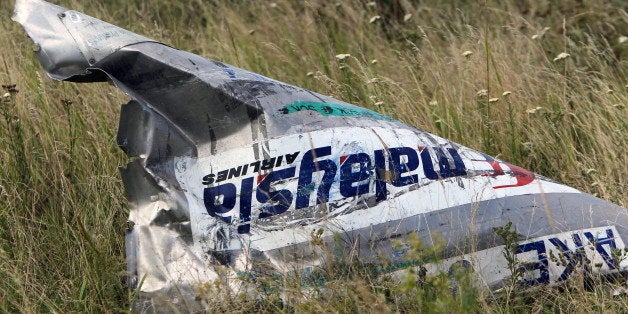
Why does a plane crash exert such a strong grip on our attention? Perhaps the answer is obvious, yet different crashes evoke such different kinds of stories, in terms of both media impact and more personal, emotional resonances.
Under normal circumstances, the experience of air travel is cloaked in awe and amazement. Who can walk past the FIDS (flight information display system) board in any airport departure lounge without fantasizing about visiting not just one but all of the destinations listed? Flights for Geneva, Casablanca, Stockholm, Toronto, Addis Ababa, Sydney, Singapore, all leaving within the hour from identical gates 50 yards apart lining a massive terminal corridor mobbed with people speaking every language and carrying packages of randomly fascinating global trinkets - dried fish, computer tablets, local crafts, liquor, jeans. Our mobility seems unlimited: the world is our oyster. We can go anywhere, and we can have everything -- physically and experientially. The airport is a hub of seemingly boundless possibility, populated by waves of humanity energized by this infrastructure of infinitude.
It's not so much the nitty-gritty of aeronautical engineering that enchants travelers: certainly, the accomplishments of the past century that have expanded our flight range from 120 feet on the Kitty Hawk beach to 16 hours across a dozen time zones are nothing short of astounding, yet few passengers have more than a crude understanding of the phenomena of lift, weight, drag, and thrust that enable this bewildering nomadism.
It is a profound cultural, rather than technological, experience that unfolds at the airport. In a minuscule amount of time we can travel someplace amazingly different from where we depart; it's an incredibly efficient enterprise. As much as we complain about cramped seats and baggage fees, how can we help but look out the window 35,000 feet above the ground and wonder what Thomas Edison (or Christopher Columbus, or Julius Caesar) would think if he could see this, if he could be where we are now? Are we not the most fortunate people who ever existed?
A few passengers, "fearful flyers," imagine with every lift-off the potential fireball, the oil slick stretching across miles of ocean, the charred suitcases strewn across a debris field. (I am a former member of this cohort -- cured only after years of therapy topped off with pharmaceuticals.) While everyone on the plane is aware that such a disaster could happen, the normal flying public is comforted by the statistical reality that air travel is a consummately safe activity.
But a plane crash disturbs the picture we have of ourselves as consummately mobile in our world, able to go anywhere at any time. An accident reminds us that unlikely as it may be, there is the possibility of failure even in a system that is flawlessly efficient 99.99 percent of the time.
The passengers on the two 747s that clipped each other on the Tenerife runway in 1977, the world's worst aviation disaster, were the victims of garbled flight-deck-to-controller communication and other twists of fate (both airplanes were supposed to have landed at the larger Grand Canary Island airport 73 miles away, which had been closed after a bombing hours earlier). The poor souls on AF 447 over the Atlantic and Colgan Air 3407 over Buffalo died due to pilots who, unaware of circumstance and weather, failed to perform one of the most basic rules of aviation -- counterintuitive, but it works: fly nose down into a stall.
A crash affects the public in terms of how strongly we empathize with the victims, the airline, the route. If it is a flight that we ourselves have taken many times, or that lands at our home airport, of course we think: that could have been us. Demographic factors -- more Westerners on one crash than another, or more children - will generate a deeper and more disturbing shock. Certain circumstances, laden with unlikely and arresting narratives, ratchet up our interest and our horror, as with the crash of EgyptAir 990 where the first officer flew the plane into a suicide dive.
An intentionally violent human action that brings down a plane is the most horrible (scary, astounding, dreadful) circumstance imaginable. The four crashes of September 11, 2001, are at the pinnacle of this horror, with Pan Am 103 and Korean Air Lines 007 not far behind.
One of the ghastly, can't-look-away fascinations of this week's Malaysian 17 crash is simply a narrative foible: coincidence. As an English professor, I can attest that coincidences happen much more often in literature than in real life. Literary coincidences, which will appear corny and sloppy if they're not done right, are necessary fictional contrivances to bring two strands of a story together in a way that normally wouldn't happen without authorial artifice. (Victorian novelists, for whatever reason, were the champions at coincidence-crafting: Dickens, Eliot, Austen, the Brontës.) That's why we like books: things work out, things connect, in ways that they often don't out in the random world.
Flight 17's illogical and ridiculous crash coincidentally recalls the other Malaysian Airlines jet that seemed to have vanished into thin air just a few months ago. Both planes were Boeing 777s: pilots call them triple-7s, though in these cases they were certainly not very lucky. The narratives that both crashes present defy rational comprehension -- and rational logic is very important to us in these events because, even if we don't understand the nuances of aviation, we know that it's based on a detailed set of precise, concrete physical facts, properties, and routines; on some level, we need to have those facts affirmed to allow us to be comfortable in flight. We need to know that the aviation industry is run by people who are like Dedalus, not Icarus.
We are filled with questions, with uncertainty, with incomprehension: Why did MH 370 turn south? Why didn't they tell the air controllers where they were going? Why did they fly six more hours to nowhere? Where is the plane? The laws of physics demand that it must be somewhere but we can't find it, which transports the story into the realm of conspiracy, twisted imagination, diabolical magic.
Who shot at MH 17, and why? Was it a mistake? Is this likely to happen again? If not over Ukraine, then over Russia? Or Iraq, or Iran, or Afghanistan, or Palestine or Israel, or Nigeria, or any of the other dozens of "hot spots" that are overflown constantly by the thousands of planes that are aloft every minute?
Commercial aviation is a fundamentally important aspect of present-day globalism, and of how we see our relationship to the rest of the world and our place in all its networks: economic, political, cultural, military. Relatively cheaply, we can get on the plane in Atlanta and step off eight hours later in Paris. Travelers can fly from Christian Rome to Islamic Tunis in an hour-and-a-half; from the impoverishment of Dhaka to the inequitably stratified wealth of Doha in six hours; from flashy technological SFO to remotely majestic ANC; from industrial Houston to underdeveloped La Paz. The world can be navigated, criss-crossed and even in some lingering imperial sense "conquered," by the miracle of flight. The airline infrastructure gives us a vital sense of empowerment.
Two Malaysian catastrophes have not destroyed that power, but they have significantly troubled it. The cause of the first crash remains an utter mystery months after the fact; and the second one, as far as we can tell in its early aftermath, was caused by recklessly brutal geopolitical cowboys. Understanding and explaining why planes crash is obviously a vital aspect of aviation safety, but in a larger psychological and cultural sense, it is a crucial facet of the cultural practice of air travel that so keenly inflects the phenomenon of contemporary globalism. We might think of the crash and the post-crash investigation as yin and yang, or alpha and omega, or thesis and antithesis -- and that last dyad poses the question of what might be the overall synthesis of this disastrous pair of crashes. How do we come to terms with these events, and integrate them into our practices and our fantasies regarding air travel?
Aviation is constantly changing: There are always new planes, new routes, new airports, new mergers, new security rituals, new economic configurations. Malaysian Airlines' annus horribilis, too, has changed the way we fly and the way we think about air travel. Two tragedies, both in the realm of "truth stranger than fiction," force us to acknowledge that lurking ominously beneath a transportation system which embodies our most advanced and far-reaching aspirations there are always the strange and frightening possibilities of violent, random, incomprehensible disruption.
--
Randy Malamud is Regents' Professor of English, and chair of the department, at Georgia State University.
